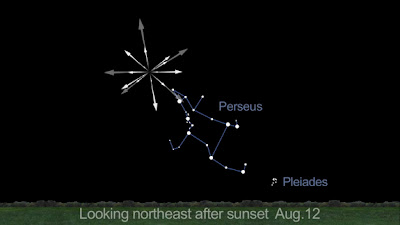August 11 – 12 is the climax of the annual Perseid meteor shower, weather permitting of course.
The best time for viewing is after
midnight to the predawn hours when the numbers will be the highest. Find a spot away from a lot of ground
lights and look to the northeast. If there is a lot of ground light,
look to the darkest part of the sky. Like most meteor showers those
with patience see the most. The meteors tend to come in batches out the
constellation Perseus, hence the name. However, they can appear in any
part of the sky but all their tails will point back to Perseus. This year the moon will have minimal effect on viewing.
The Perseids occur every year as the Earth passes through a stream of
dust particles and debris from the Comet Swift-Tuttle. These particles
hit the earth’s atmosphere at speeds up to 140,000 mph and become heated
to form bright streaks across the sky – shooting stars. The shower is
at its peak or climax when the earth passes through the middle of the
tail debris. For those willing to stay up later or get up extra early,
there is an added treat as this meteor show has the most fireballs of all the meteor showers this year. So get out a blanket,
lay on your back and enjoy the show. And don't worry if you miss the peak, the show this year lasts from July 17 - Aug 24th. Picture credit: NASA/JPL-Caltech.
Saturday, August 10, 2013
Subscribe to:
Post Comments (Atom)





No comments:
Post a Comment